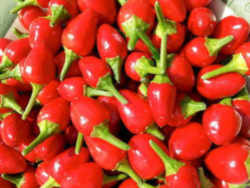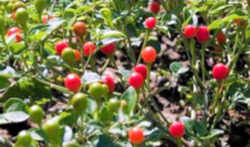
Texas Symbols
Texas State Native Pepper
Chiltepin

(Capsicum annuum var. aviculare)
Adopted on June 18, 1995.
Symbols that represent the Southwest in homes across the United States and beyond are hot. New Mexico adopted the chili (or chile) and frijoles (pinto beans) as its state vegetables because they are often eaten together. Not to be outdone, Texans named the jalapeño their official state pepper June 18, 1995. In 1997, they crowned the chiltepin, (Capsicum annuum var. aviculare,) their official "native pepper."
The chiltepin, called the "mother of all peppers," is thought to be the oldest known of the Capsicum genus, as well as the hottest wild variety in the Americas even hotter than the habanero. They grow on the rocky surfaces of steep slopes and are difficult to find because they are usually protected by other shrubbery.
Texas State Native Pepper: Chiltepin
Pepper Profile: Chiltepin

Also known as Chiltecpin or simply Tepin, from the Nahuatl Mexican word meaning "flea".
Family: Solanaceae
Genus: Capsicum (KAP-sih-kum)
Species: annuum var. aviculare
The piquin is a pod type of the annuum species. The word "piquin," also spelled "pequin," is probably derived from the Spanish word "pequeño," meaning
small, an obvious allusion to the size of the fruits. Variations on this form place the words "chile" or "chili" before or in combination with both
"pequin" and "tepin" forms. The word "Chiltepin" is believed to be derived from the Aztec language (Nahuatl) combination word "chilli" + "tecpintl,"
meaning "flea chile," an allusion to its sharp bite. That word was altered to "chiltecpin," then to the Spanish "chiltepín," and finally Anglicized
to "chilipiquin," as the plant is known in Texas.
The piquins are also known by common names such as "bird pepper" and "chile mosquito." Most are unnamed varieties, both wild and domesticated, varying
in pod size and shape from BBs to de Arbol-like fruits. Generally speaking, the wild varieties (spherical "tepins") are called chiltepins and the domesticated
varieties (oblong "piquins") are called piquins or pequins, but in Texas the wild varieties are called chilipiquins. They categorize as an edible fruits
and nuts, and vines and climbers.
The Plant
Piquins vary greatly, usually having an intermediate number of stems and an erect habit.
Chiltepins are one of the few crops in the world which are harvested in the wild rather than cultivated. (Others are mushrooms, piñon nuts, Brazil nuts, and some wild rice.)In the wild, piquins can grow 6 feet high or more, and in the greenhouse they have grown 15 feet high in one season. However, some varieties have a prostrate habit, spreading across the ground like a ground cover.
The leaves are medium green and are lanceolate or ovate, measuring about 3 1/2 inches long by 1 1/2 inches wide. The flower corollas are white with no spots. They blooms all year and repeatedly.The pods are borne erect, are round or oblong, and measure between 1/4 and 1/2 inch long and wide.
Domesticated varieties from tiny and round, but usually have elongate, pointed pods, usually borne erect but occasionally pendant, sometimes measuring up to 2 inches long.
Piquins are extremely hot, measuring between 50,000 and 100,000 Scoville Units. In Mexico, the heat of the Chiltepin is called arrebatado ("rapid" or "violent"), which implies that although the heat is great, it diminishes quickly.
Agriculture
Botanists believe that these wild chiles are the closest surviving variety to the earliest forms of chiles which developed in Bolivia and southern
Brazil long before mankind arrived in the New World. The small size of their fruits were perfect for dissemination by birds, and the wild chiles spread
all over South and Central America and up to what is now the United States border millennia before the domesticated varieties arrived. Ethnobotanists
believe that birds were responsible for the spread of most wild chiles, and the chiltepin is called the "bird pepper." Attempts at domestication of
the wild plants have led to the development of the commercial chile piquin, which grows under cultivation in Mexico and Texas. A cultivated form of
the chiltepin has been grown successfully in Sonora and in the Mesilla Valley of New Mexico, where they are planted as annuals. In all cases of domestication,
the cultivated forms tend to develop fruits larger than the wild varieties; botanists are not certain whether this trait is the result of better cultural
techniques or the natural tendency for humans to pick the largest fruits, which contain next years' seed.
In the US, about a thousand acres of "small chili" are cultivated, mostly in Texas and New Mexico. Many of these chiles are packaged and labeled as
piquin regardless of the shape of their pods--from those resembling red peppercorns to those which look like small New Mexican varieties--and there
is no way to tell which are cultivated and which are collected in the wild.
Piquins do well in the home garden and are particularly suited to being grown in containers as perennials. Garden writer Paul Bessey of the Arizona
Daily Star reports that rosy-headed house finches regularly decimate his ripening chiltepins, so some netting protection from birds may be necessary
when growing this variety. The growing period is at least 90 days, and the plant can produce between 50 and 100 pods, depending on its size and growing
period.
Lore
Archaeologists in Mexico have discovered evidence that humans were chomping on wild chiles, called chiltepins, during prehistoric times - as far back as 7500 B.C.
The Tarahumara Indians of the Sonoran Desert in Mexico believe that chiltepins were the greatest protection against the evils of sorcery. One of
their proverbs holds that "The man who does not eat chile is immediately suspected of being a sorcerer." The Papago Indians of Arizona maintain that
the chiltepin "has been here since the creation of the earth."
Popular folklore holds that Texans love chile Piquins so much they eat them right off the bush. In fact, their infatuation is so great that Piquin-heads
rarely travel far from home without an emergency ration of the tiny pods, either whole or crushed, in a silver snuffbox or pillbox. Texans also reputedly
use the chile Piquin in place of soap to punish children for using "cuss words."
Culinary Usage
The red dried chiltepin is crushed into soups, stews, and bean dishes. The green fruit is chopped and used in salsas and bottled en escabeche.
Texas House Concurrent Resolution No.82
Texas HOUSE CONCURRENT RESOLUTION
By Carter
H.C.R. No. 82 75R5343 JHS-D
WHEREAS, The Lone Star State's reputation as a haven for lovers of hot and spicy food is well deserved, and the native chiltepin pepper has contributed
greatly to this proud legacy; and
WHEREAS, A member of the genus Capsicum, the chiltepin grows wild in our temperate climate and is both undeniably American and typically Texan; its
distinctive flavor makes it ideal for hearty stews and red-hot Texas chili, and it is a staple in many Tex-Mex favorites; and
WHEREAS, Even the mockingbird, our state bird, recognizes the appeal of this piquant pod, choosing to dine on it almost exclusively when the pepper
is in season; wild turkeys, too, are often seen feeding on these tasty little morsels, and these and other fruit-eating wild birds play a vital role
in the chiltepin's proliferation; and
WHEREAS, Found in abundance from the southern United States to northern South America, the chiltepin has been used for many years by the various peoples
who have populated our great state; known variously as chile mosquito and chile bravo, the Spanish described this zesty fruit as "arrebatado," meaning
that although its spiciness is immediate and intense, this bold sensation does not linger long; and
WHEREAS, The chiltepin is used in both fresh and dried forms, combined with vinegar to make a tangy sauce or sprinkled into soup to provide just the
right seasoning; perhaps the most amazing attribute of this indigenous spice is that it has been shown to increase the human metabolism by as much
as 25 percent, making it a promising means of controlling weight gain; and
WHEREAS, The chiltepin's storied history even includes a footnote to one of our greatest American presidents, Thomas Jefferson; an avid gardener, President
Jefferson acquired some of these exotic tiny peppers from a fellow horticulturist and displayed a keen interest in establishing a market for this Texas
pepper; and
WHEREAS, It is important to acknowledge and promote our endemic natural resources, for they are an integral part of our heritage and help to make us
recognizable to other cultures around the globe; the chiltepin is Texas' only native pepper, and its long history and wide variety of uses make it
truly deserving of special recognition and endorsement; now, therefore, be it
RESOLVED, That the 75th Legislature of the State of Texas hereby declare the chiltepin the official State Native Pepper of Texas.
House Concurrent Resolution No. 82, 75th Legislature, Regular Session (1997)
Texas Law
The chiltepin was named the official state native pepper of Texas by House Concurrent Resolution and is not, therefore, listed in the Texas Statutes.
Taxonomic Hierarchy: Chiltepin
Kingdom: Plantae - Plants
Subkingdom: Tracheobionta - Vascular plants
Superdivision: Spermatophyta - Seed plants
Division: Magnoliophyta - Flowering plants
Class: Magnoliopsida - Dicotyledons
Subclass: Asteridae
Order: Solanales
Family: Solanaceae - Potato family
Genus: Capsicum L. - pepper
Species: Capsicum annuum L. - cayenne pepper
Variety: Capsicum annuum L. var. aviculare
(Dierbach) D'Arcy & Eshbaugh
- cayenne pepper

List Official US State Foods






